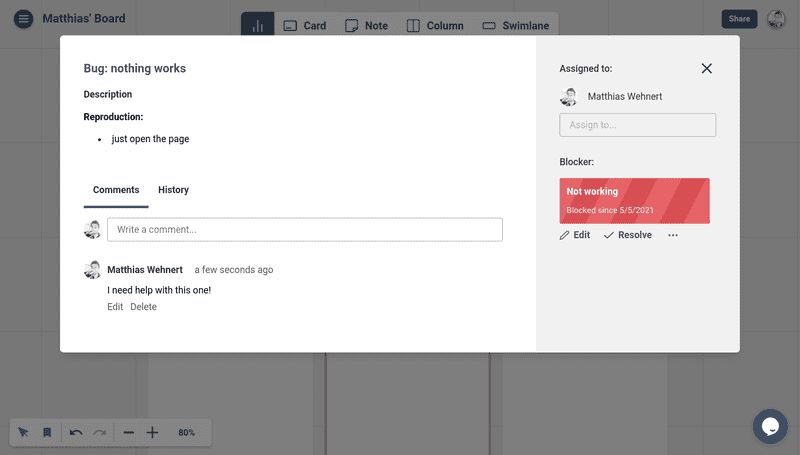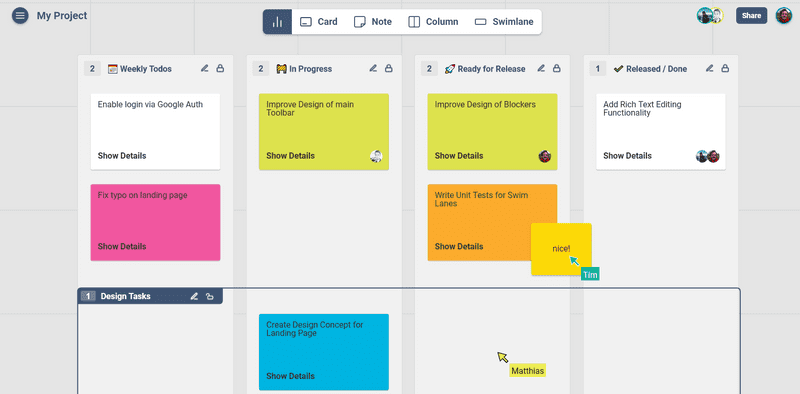It is time for a new approach to digital Kanban boards
tl;dr When doing Kanban physical whiteboards are super flexible but can’t handle the challenges of distributed teams. Most project management solutions are not flexible enough and digital whiteboard tools do not support you as much as they could when doing Kanban. We build yokanban! which gives you the best of physical and digital world and I can tell you: it is great! 😍
Introduction
As a software developer you have to know what it means to be agile nowadays. Agile is so omnipresent, that I started my one only other blog post about Kanban in Development Teams from 2 years ago in a very similar way. Everyone, everything is agile: Your next job offer, the next project you will work on, you as a person. But how agile are the tools you are working with?
To be honest: agile is one of these buzzwords, that is completely overused and therefore many folks just react with a “omg, not agile again” or something similar. You get what I am talking about. But apart from all the buzzy noise around the term, agile software development has lots of advantages (and pitfalls, too, of course).
A way to implement a agile software development process is to do Kanban. I will not go into detail on Kanban in this post (find a more detailed description in this post), but if you review modern project management software solutions you’ll see “it’s a thing”. Nearly every big player (e.g. Jira, Asana, etc.) has features for Kanban, most importantly a Kanban board. And there are even tools explicitly designed to implement Kanban for your process and this is not even limited to software development. It works for design and basically every other knowledge work modelling process as well.
The Whiteboard
But there is one thing that lots of Kanban coaches will tell you that outplays the digital tools when it comes to start Kanban: the whiteboard! Plain old white board. And one of the key advantages is: Flexibility!
Make two or three columns with a board marker onto a whiteboard, get some sticky notes and you are good to go. Need a new column? Just draw a line. Sticky notes in just one color do not match your needs anymore? Get colored sticky notes. What to rearrange the columns on the board? Erase them and redraw the board, rename columns, do whatever you like. It is just the easiest thing to do.
But why is flexibility so important for Kanban: Because Kanban embraces change. Not one time, “big bang”-like, revolutionary change, but small, steady, evolutionary change. Therefore it should be easy to modify your board and therefore it is often recommended to start with a whiteboard. Everything is ready to be changed if it is not “fit for purpose”. Every little change is an experiment with one big goal: getting better. 📈
The Problems with Current Tools
The trouble I had in various projects was, that the used tools were far from being easy to customize. Not that it wasn’t possible at all, but it was hidden behind big configuration dialogs, clunky menus and often limited to project- or board-admins. And sometimes tbh it was just not possible only because the Kanban tool that was being used had not thought of that special usecase. The result was, that adjusting the board to our needs as we used it was always a pain in the…please finish this sentence yourself. In conclusion: the software that is meant to help the team to be agile isn’t agile itself. 😕
You’d say, “You just told us about the advantages of a physical Kanban board, then go ahead and use one, if Jira, Trello, whatsoever do not fit your needs.” But something that makes that difficult is one of the major disadvantages of good old whiteboards: Distributed Teams and remote work. It just doesn’t work. Even if you would imagine 2 subteams that share one physical Kanban board and you would stretch and keep the boards in the teams offices in sync somehow: It does not scale at all.
Digital Whiteboard Tools
Some teams I know chose a trade-off. They started using digital whiteboard tools to visualize what they would have done on the physical whiteboard otherwise. This was a very smart move, because modern whiteboard tools on the internet like Miro or Concept-Board pretty much include all major features of the whiteboard on your office wall. But although some of these tools even include features that target Kanban or at least cards and columns especially, they can feel somewhat overwhelmingly complex for something as simple as having cards, columns, maybe swimlanes and hopefully not too much blockers.
For sure, these tools are not dedicated Kanban tools. They aim to be everything you wish from a whiteboard and they achieve that goal mostly pretty well. But what is a big strength when you are looking for a digital whiteboard, becomes the weakness when you want to use it as a digital, but still whiteboard-ish Kanban board. Why? Because they can not focus on satisfying Kanban user’s needs.
When you are already using a digital tool to allow various parties from different places to participate, why should this digital tool not provide you with the powerful features that made digital tools in our lives so omnipresent? Why should this tool not support your Kanban change process in every possible way? Why should it not track your metrics? Allow for explicit blockers, swimlanes, columns and multi-functional cards? I don’t think there is any reason for that. It is just: Noone has ever focused on that sweet spot before.
yokanban! is different
yokanban! is a new digital tool, which focuses explicitly on the sweet spot between digital whiteboard, physical Kanban boards and legacy project management software.
I need to come clean now: I am part of the development team of yokanban! at dynabase and therefore somewhat biased, but I tell you: yokanban! is the digital Kanban board I have dreamed of for so long as a Kanban fanboy 🤤. We are already using our own tool for the product development of yokanban! (eat your own dog food!) and I don’t know any other tool out there which would provide us with this flexibility we love on the board while supporting us with helpful features doing our Kanban workflow at the same time.
The featureset of yokanban! is constantly growing (while always having in mind to target the sweet spot we were talking about earlier). Right now it includes for example:
- all important elements a Kanban board needs: columns, cards, swimlanes, blockers, notes
- live collaboration and comments on cards
- Basic metrics and history by card
- WIP limits on columns
 A simple board with a blocker and a broken WIP limit
A simple board with a blocker and a broken WIP limit
 The card detailview with comments, description and other cool stuff
The card detailview with comments, description and other cool stuff
This allows to create simple and complex Kanban boards on which users can collaborate regardless from where they are participating. Check out how yokanban! is evolving and what is up next on yokanban.io/releases or try it out yourself on app.yokanban.io - it’s free 🤑.
In upcoming posts I will go into detail on how to use yokanban! for different usecases. And guess what: while using it ourselves we found out it not only helps with creating Kanban boards 🤯.
Matthias Wehnert is a JavaScript-Developer from 📍Bonn. He is 36 years old and loves building beautiful things on the web 🚀! Do you want to learn more about him 👋? Or his work 👷? Or get in touch 📫?


